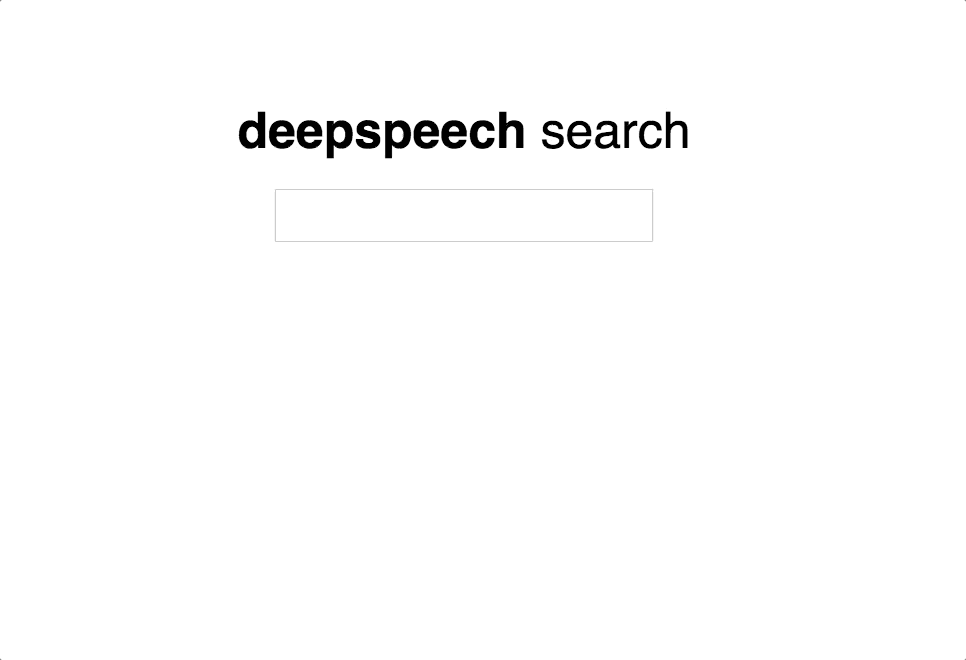Project DeepSpeech is an open source Speech-To-Text engine implemented by Mozilla, based on Baidu's Deep Speech research paper using TensorFlow.
This particular repository is focused on creating big vocabulary ASR system for Russian language (paper).
Big datasets for training are being crawled using developed method (paper) from YouTube videos with captions.
Labeled russian speech (CSVs + wav):
- yt-subs-rus-6k (6K hours, raw, 543GB)
- yt-vad-650-clean (650 hours, cleaned, 56GB)
- random samples from yt-subs-rus-6k (274MB)
Used language model:
Developed speech recognition system for Russian language achieves 18% WER on custom dataset crawled from voxforge.com.
Created ASR system was applied to speech search task in big collection of video files. Implemented search service allows to jump to a particular moment in video where requested text is being spoken.
Here is a demo:
Please write to george.fedoseev@me.com for any questions and support.
Using released files
You will need Mac OS or Linux
- Follow this Mozilla's DeepSpeech guide to install pip3 deepspeech package.
- Go to releases and download
tensorflow_pb_models.tar.gzandlanguage_model.tar.gz. - Unpack all files (
output_graph.pb,lm.binary,trieandalphabet.txt) to some folder. And run inference:
deepspeech output_graph.pb alphabet.txt lm.binary trie my_russian_speech_audio_file.wav
Checkpoint is a directory that you specify as --checkpoint_dir parameter when training with DeepSpeech.py. You can continue training TensorFlow acoustic model from released checkpoint with your own datasets.
Released checkpoints are using --n_hidden=2048 (number of neurons in hidden layers in neural network), and it cannot be modified if you want to use this released checkpoint (for values other than 2048 it will throw an error).
To use released checkpoint in your training:
- Follow Training setup guide
- Extract
checkpoint_dir.tar.gzarchive downloaded from release somewhere in your/network/checkpointsdirectory (or any other). Change absolute paths to main checkpoint file incheckpointtext file. Example ofcheckpointfile contents:
model_checkpoint_path: "/network/DeepSpeech-ru-v1.0-checkpoint_dir/model.ckpt-126656"
all_model_checkpoint_paths: "/network/DeepSpeech-ru-v1.0-checkpoint_dir/model.ckpt-126656"
- Train with your own datasets setting
--checkpoint_dirparameter to directory that you extracted checkpoint to.
- Requirements
- Setting up training environment
- Define alphabet in
alphabet.txt - Generate language model
- Training on sample dataset
- Setup Telegram notifications
- Good NVIDIA GPU with at least 8GB of VRAM
- Linux OS
cuda-command-line-toolsdockernvidia-docker(for CUDA support)
- Check
nvidia-smicommand is working before moving to the next step - Clone this repo
git clone https://github.com/GeorgeFedoseev/DeepSpeechandcd DeepSpeech - Build docker image based on
Dockerfilefrom clone repo:
nvidia-docker build -t deep-speech-training-image -f Dockerfile .
- Run container as daemon. Link folders from host machine to docker container using
-v <host-dit>:<container-dir>flags. We will need/datasetsand/networkfolders in container to get access to datasets and to store Neural Network checkpoints.-dparameter runs container as daemon (we will connect to container on next step):
docker run --runtime=nvidia -dit --name deep-speech-training-container -v /<path-to-some-assets-folder-on-host>:/assets -v /<path-to-datasets-folder-on-host>:/datasets -v /<path-to-some-folder-to-store-NN-checkpoints-on-host>:/network deep-speech-training-image
- Connect to running container (
bash -ccommand is used to sync width and height of console window).
docker exec -it deep-speech-training-container bash -c "stty cols $COLUMNS rows $LINES && bash"
Done! We are now inside training docker container.
All training samples should have transcript consisting of characters defined in data/alphabet.txt file. In this repository alphabet.txt consists of space character, dash character and russian letters. If sample transcriptions in dataset will contain out-of-alphabet characters then DeepSpeech will throw an error.
Run python script with first parameter being some long text file from where language model will be estimated (for example some Wikipedia dump txt file)
python /DeepSpeech/maintenance/create_language_model.py /assets/big-vocabulary.txt
This script also has parameters:
- o:int - maximum length of word sequences in language model
- prune:int - minimum number of occurences for sequence in vocabulary to be in language model
Example with extra parameters:
python /DeepSpeech/maintenance/create_language_model.py /assets/big-vocabulary.txt 3 2
It will create 3 files in data/lm folder: lm.binary, trie and words.arpa. words.arpa is intermediate file, DeepSpeech is using trie and lm.binary files for language modelling. Trie is a tree, representing all prefixes of words in LM. Each node (leaf) is a prefix and child-nodes are prefixes with one letter added.
Dataset consists of 3 sets: train, dev and test. For each set there is CSV file and folder, containing wave files. In csv each row contains full path to audio, filesize in bytes and text transcription. For saving-space-in-repo purposes sample dataset has only 9 audio recordings (which is enough for demo and not enough for good WER). CSV file for train set repeats same 3 rows 7 times to simulate more data.
To run demonstration of training process execute:
bash bin/train-tiny-dataset.sh
You should see training and validation progressbars running for each epoch. Training process stops when validaton error stops decreasing (early stopping). Then starts testing phase that uses language model (LM is not used during trainig), thats why it takes longer time for each sample to process (beam search implementation that uses language model is one-threaded and CPU only).
Obviously with so tiny dataset good WER is not achievable. To achieve good WER (at least < 20%) use datasets with > 500hrs of speech.
You can examine which parameters are passed to DeepSpeech.py script by checking contents of train-tiny-dataset.sh file.
Because training big RNNs like in DeepSpeech takes time (from few hours to days and even weeks on weak hardware), its good to be notified about training results and not to check manually all the time.
You can use Telegram Bot to send you log messages. Create bot in Telegram and get accessToken, start chatting with bot and get chatId. Then create telegram_credentials.json file in the root folder of the project with following contents:
{
"accessToken": "<your-access-token>",
"chatId": "<your-chat-id>"
}
To tell DeepSpeech.py to send you log messages through your Telegram Bot to specified chat add flag --log_telegram=1 when running training.
